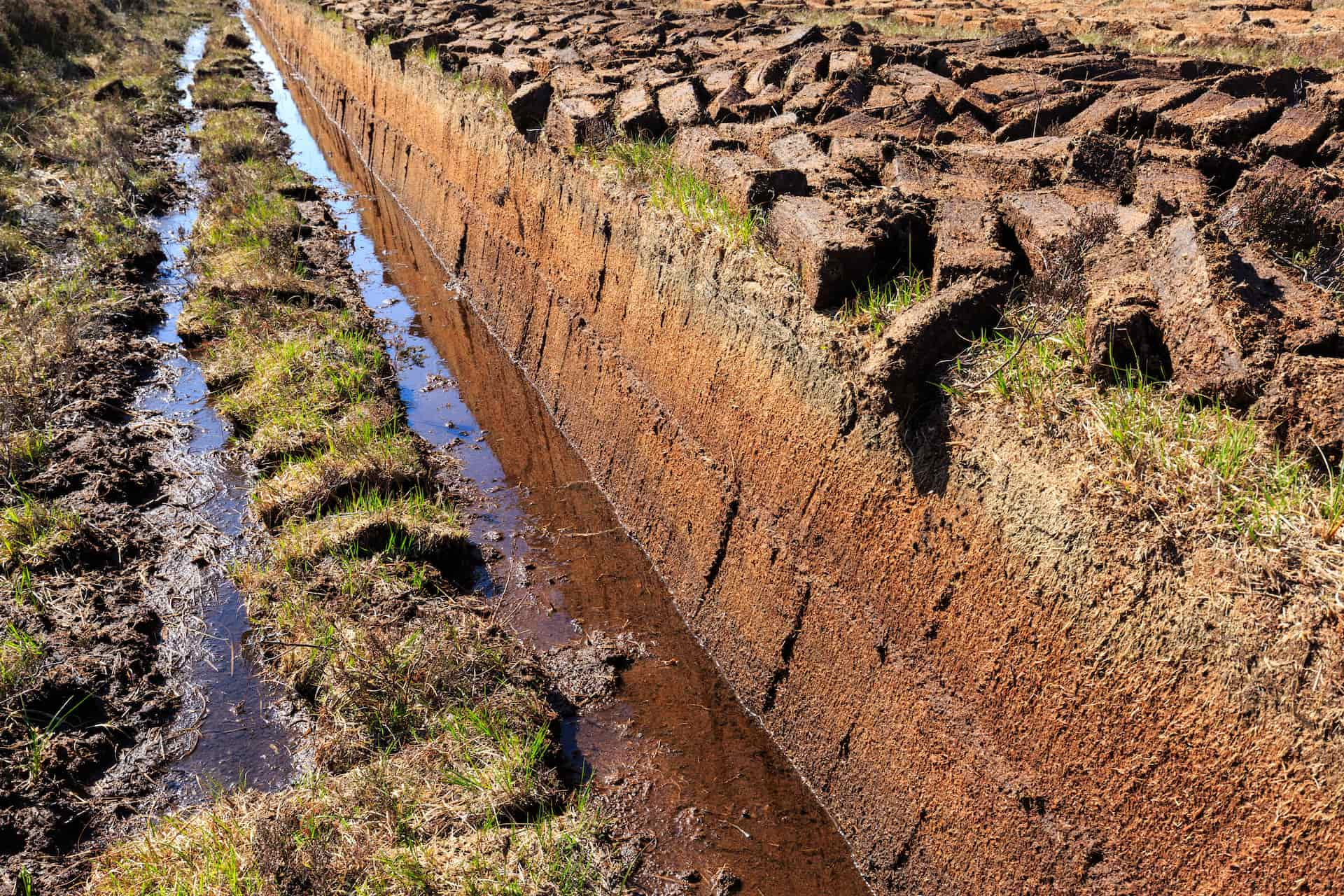Peat - Once synonymous with the majority of Scottish whisky production, is now somewhat polarising in todays world. An almost fossil fuel with limited supply and environmental consequences. Here we explore the history of peat, where it comes from and the whisky industry's challenge of balancing environmental impact with heritage and history.
Smoke, Iodine, Earth, Tar, Medicine, Brine, Barbecue, Ash... Very few flavours in the whisky world spark more passion, or more debate, than peat. Certainly an acquired taste and to some it’s the soul of Scotland in a glass, evocative of windswept coastlines and crackling hearths. To others, it’s like licking a bonfire. But however you feel about it, peat is woven deep into the story of Scotch whisky.
What Exactly is Peat?
Firstly let's look into just what peat actually is.
Peat is made up of partially decomposed plant and other organic matter that has built up over thousands of years in waterlogged environments like bogs and moorlands. In Scotland's rugged landscapes, it’s mostly made up of mosses, sedges, and heather that have compacted into dense, carbon-rich layers, think of it as nature’s slow-burn fuel.
It takes centuries and sometimes even millennia for peat to develop and only occurs under very unique conditions, where a mass of organic materials don't fully compose in wet moorlands and bogs. Any disruption to a peat bog can result in the area no longer producing peat. It is a very delicate ecosystem and naturally is a very dense store of carbon.
Why Does Peat Taste Different Depending on Where It’s From?
Not all peat is created equal in fact far from it, peat is completely unique in make up based on the location and the plant life found in the area. Its flavour profile depends on:
- Botanical makeup – Peat from coastal regions (like Islay) contains seaweed and salt-tolerant plants. Highland peat however is much richer in heather and lichens.
- Depth of cut – Shallower cuts have lighter, grassier smoke; deeper cuts tend to be richer and more medicinal.
- Moisture and burn temperature – The way peat burns during kilning affects how phenols interact with the barley.
The variety in the make up of peat translates directly into the variety of flavours that are produced from drying malted barley using peat from different locations. Terroir applies to peat just as much as it does to grapes in wine.
This is why an Orkney peat reek is not the same as an Islay reek. Flavours typically associated with peat from different areas;
- Islay - Synonomous with briney, medicinal smoke. Tar, saline, BBQ are often associated. An incredibly unique and sought after profile.
- Highlands - Sweeter, earthy and more herbaceous flavours influence the rich smoke of Highland peat.
- Orkney - Orkney with its unique flora has a peat that is softer and less intensely smoky with a sweet earthy tang.
The 'peatiness' of a whisky is measured in parts per million (PPM) and the amount of peat present in distillate will greatly affect the final flavour. A lightly peated whisky such as Ardmore may have 12-14ppm, while a Lagavulin, known for its intense medicinal smoke sits around 35ppm. Then you can explore heavy peat with Ardbeg averaging around 50-55ppm and all the way up to the eye-watering super-heavy peated whisky, Octomore from Bruichladdich, the 8.3 batch holds the record as the most heavily peated whisky in the world at 309.1ppm, quite the experience.
A Brief History of Peat in Whisky
In the early days of whisky production, long before the industrial revolution, distillers had limited fuel options for firing the stills, drying the barley and operating the distillery. In many parts of Scotland, especially on the islands and in remote Highland regions, peat was an abundant fuel source that could be locally harvested. In these remote and rural areas trees and forests are scarce as they struggle to grow in colder, wetter and oceanic climates, with little wood to burn, an alternative was needed. So peat was harvested and cut from the bogs and moorlands before being dried in the sun and used as a source of fuel for fires.
For distilleries drying barley over a peat fire was necessary, practical and eventually traditional, and the resulting smoky character became a hallmark of whiskies from these areas.
By the late 19th and 20th centuries, as coal and other fuels became more readily available, many mainland distilleries moved away from peat smoke in favour of cleaner malting methods. Yet on Islay, Orkney, and certain parts of the Highlands, peat remained central to regional style, cementing their smoky identities on the Scotch whisky map.
In modern whisky making the role of peat is much-less about heating stills and operating the distillery and more about flavour: burning peat to dry malted barley imparts its phenolic compounds that give those famous and unique smoky, medicinal, and earthy notes.
The Peat Controversy: A Resource Under Pressure
In recent years, as modern awareness of environmental issues has become more commonplace, peat use has come under environmental scrutiny. Peatlands are vital carbon sinks, locking away vast amounts of CO₂ and supporting rare biodiversity. Harvesting peat releases stored carbon and disrupts fragile ecosystems.
The situation is compounded by the fact that peat regenerates at a glacial pace, roughly 1mm per year. In other words, the peat used in your dram took thousands of years to form and won’t be replaced in our lifetime.
Some conservationists argue that whisky’s use of peat is relatively small (approximately 1% of the extracted peat) compared to horticulture where vast amounts are dug up for garden compost, though a UK ban has still been implemented and phasing out the use in amateur gardening products has already begun. Whisky distillers can continue to use peat though there is growing pressure to pass a complete ban. Which begs the question, what will Scottish whisky do without peat?
Are We Running Out of Peat?
Scotland is certainly not about to run out of peat anytime soon with 20% of Scotland's landmass being peat bogs and moorlands, but there is an knowledge that this is a finite material and there’s a growing push to protect remaining peatlands. The Scottish Government has pledged to restore significant areas, and some whisky producers are investing in conservation projects or exploring more sustainable harvesting.
The question is less about absolute depletion and more about ethics, sustainability, and the image of Scotch whisky in an environmentally conscious world.
Peat and the Future of Scotch
Peated whisky will not vanish overnight, it’s far too culturally and commercially important, and its production accounts for a fraction of total peat extraction in the UK.
However, expect to see:
- Tighter regulations on how peat is sourced and how much can be extracted.
- Peatland restoration projects funded by whisky brands.
- Innovation in smoke flavouring, from alternative fuels to phenol capture technology, allowing smoky whisky without traditional peat burning.
For drinkers, the romance of peat is as much about tradition and place as it is about taste. But in the decades ahead, the industry will have to find a balance between preserving that heritage and protecting the landscapes that make it possible.
Peat is more than just a fuel in the production of whisky, it is a cultural flag and an essential part of Scotland's unique whisky heritage.
Bottling Guide
Download our comprehensive bottling guide to learn everything about the bottling process, from cask selection to packaging and final delivery.
Contact
Our Sales Expert
Reach out to our team for personalised advice and more information on our bespoke whisky services. We’ll help tailor the perfect experience for you.


.jpg)


